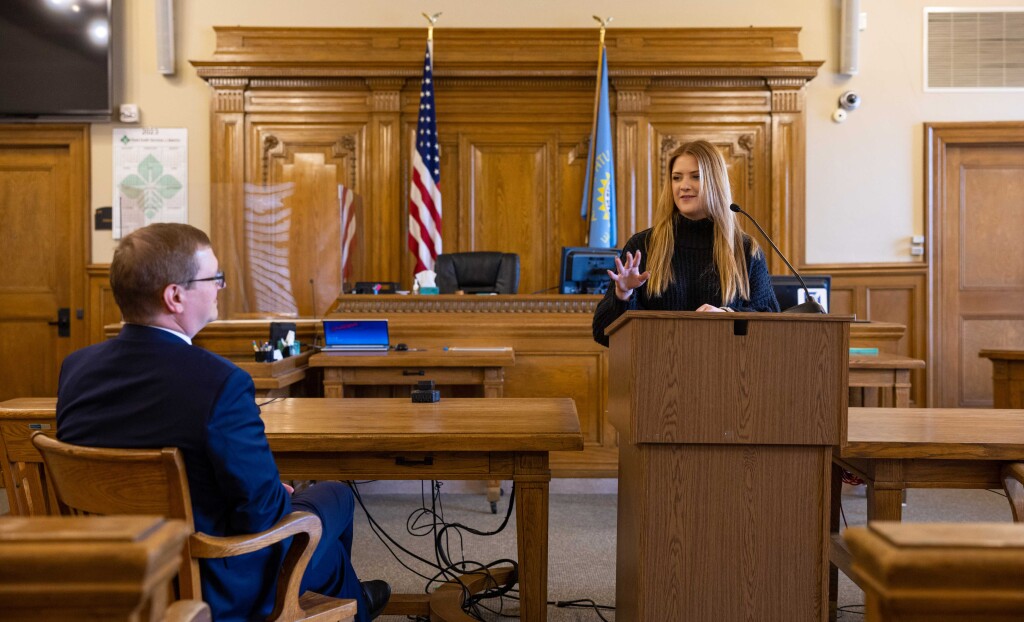Alumni Association launches program pairing students, grads
What significance can be achieved in one hour a month?
Ask Ellen White, Anna Shane ’23, Amanda Roesler ’23 or any of the 33 other SDSU upperclassmen who participated in the inaugural SDSU Alumni Mentor Program. The pilot program has been overwhelmingly successful and is being opened to any SDSU student who has earned 60 credit hours heading into fall semester, according to Travis Jensen ’04/M.Ed. ’12, vice president of leadership initiatives at the Alumni Association who oversees the program.
“The long-term relationships I have built with this program are so meaningful to me,” said Roesler, who graduated in May with degrees in microbiology and human biology.
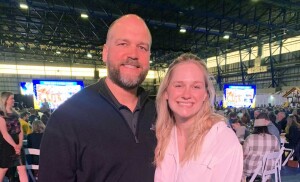
Amanda Roesler poses with her mentor, James Johnston, a podiatrist practicing in Aberdeen, at the SDSU Athletic Scholarship Auction April 29. Roesler will be entering med school in the fall.
The Leonard, North Dakota, resident and future University of South Dakota Medical School student was paired with Dr. James Johnston ’05, a podiatrist practicing in Aberdeen. The formal mentoring program is for one school year—October through April, but Roesler said Johnston has asked her to “always make sure to reach out to him while I’m in med school and notify him when I am graduating. I have somebody in my corner; to have someone to lean back on can be really helpful, I think.
“This program is going to be really great for both mentees and mentors. I can see myself coming back and engaging as a mentor and giving back to the program.”
Flexible structure aids program
The program was structured, but not stifling, participants say. “Each month there were structured activities and conversations with the goal of helping students gain soft skills,” said Jensen, who was hired in June 2022 and tasked with getting the program off the ground. He spent a month researching mentor programs, including the gold standard at Marquette University, where he met with its director.
White, an exercise science and Spanish major from Minnetonka, Minnesota, said, “I think this program, they are really setting us up for success in what they gave us for activities. They choose really meaningful activities for us to do.
“For example, we didn’t just have a generic review of strengths and weaknesses, but how are you going to work to improve these things or what areas are you insecure about in your application. Like for me, I’ve never been a CNA (certified nurse assistant) like my peers. (My mentor) encouraged me not to be so self-conscious about that and use the other things I have done to my benefit.”
Making a strong resume stronger
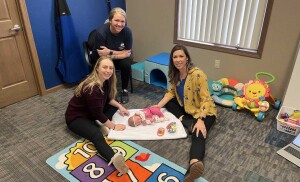
Ellen White, left, and Trisha Rieffenberger spend time with Lennon Jordan while her mother, Abigail, looks on during a visit to Big Stone Therapies in Watertown. White said she was thankful her shadowing sessions had more hands-on time than many other shadowing sessions.
White was paired with Trisha Rieffenberger, a 2003 SDSU grad and physical therapist at Big Stone Therapies in Watertown.
Rieffenberger said, “Ellen is hoping to get into physical therapy school. So, I talked to her about how to make yourself look like a great candidate for graduate school. I suggested she volunteer with the elderly and in a hospital setting. She already has started a nonprofit, done some foreign travel and is fluent in Spanish. So, her resume is strong.
“But physical therapy programs are very competitive. I wanted to give her that edge so she can take that next step.”
Of course, not every mentoring activity will fit each pair. Roesler and Johnston turned a potential negative into a positive, she said.
“Initially, it was challenging finding ways to meet the activities we were given and finding ways to make them practical to me. For example, LinkedIn—a lot of doctors don’t use that. But once we realized this wasn’t about checking the boxes, but making it beneficial to the both of us, then it went a lot better,” Roesler said.
Top students form first class
For the 2022-23 pilot year, students had to be members of the Van D. and Barbara B. Fishback Honors College or Students’ Association or have been a graduate of LeadState, a leadership program for sophomores.
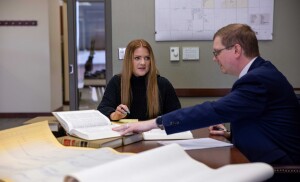
Ben Kleinjan, Brookings County deputy state’s attorney, discusses points of criminal law with Anna Shane during a session at the county courthouse as a part of her mentoring program.
Shane was Students’ Association vice president in 2022-23 and has plans to enter law school in 2024. She was paired with Ben Kleinjan, a 2006 SDSU grad who is Brookings County deputy state’s attorney.
Shane, who graduated in May with degrees in political science, Spanish and global studies, said, “It can be really hard in some majors to find a mentor. I didn’t know any lawyers. The most exciting thing was to be paired with someone who could tell me what it is like to be a lawyer.”
Neither Kleinjan nor Shane come from families of lawyers and both were involved in student government at State, so it wasn’t hard for them to bond, especially over a cup of coffee at Kool Beans downtown. “Face to face was really helpful,” Shane said.
Program ends, relationship doesn’t
While their formal meeting sessions have ended, Kleinjan said, “She’s got a reference for life as far as I’m concerned. … There is no such thing as a last session. I’m going to bug her for a long time.”
That’s just fine with Shane. “At first I was intimidated by hearing who all the mentors were—CEOs and people who lived in D.C. After that first meeting, that went away. Yes, meeting in person helped. I go to Kool Beans twice a week anyway,” the Sioux Falls resident said.
The Alumni Association did sponsor an October kickoff that brought most mentors back to campus. Rieffenberger said, “I really enjoyed being on campus for the kickoff event. It’s probably been 10 years since I was on campus. It was a
fun year to be reconnected with SDSU given the school’s athletic success.
“We’re already talking about bringing our kids down for some football games. It’s sparked my desire to plug my whole family into the Jackrabbits thing.”
‘Alumni … want to give back’
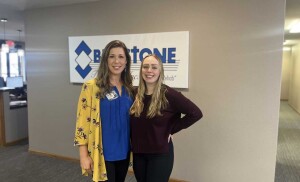
Trisha Rieffenberger, left, and Ellen White had a couple shadowing sessions at Big Stone Therapies in Watertown, where Rieffenberger is a physical therapist.
She said she is willing to continue in the program. “I’ve even thought about a couple people who would be great mentors,” said Rieffenberger, who said she met Jensen when she was a freshman at State.
Jensen hopes that attitude is shared by the 35 other mentors—there are 96 students already signed up for the program in 2023-24. He is confident they are up for the challenge. “We’re very fortunate we have an alumni base that wants to give back,” he said.
In fact, the program was started because Alumni Association President Andi Fouberg ’99 and Alumni Relations Director Annie Hanson ’04 kept hearing alumni ask, “How else can we give back?” and talking about mentoring.
Kleinjan, who is battling multiple sclerosis, said the mentoring program came along at a good time in his life.
“MS has given me an opportunity to reflect on a deeper basis, ‘What am I trying to do here?’
“As you mature, you figure out what things are important. MS is one of those things that screams, there is very little in your life that is important, so maybe you should spend some time helping other people.”
Dave Graves

